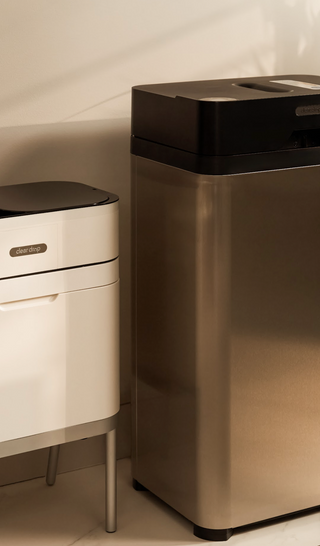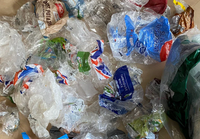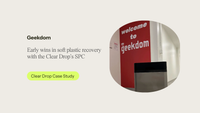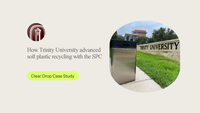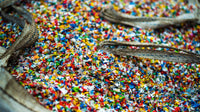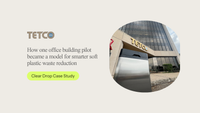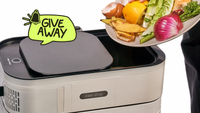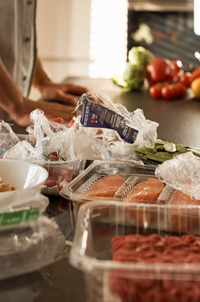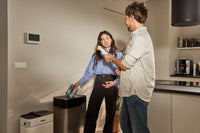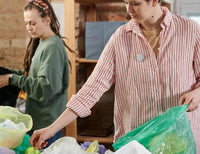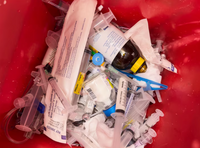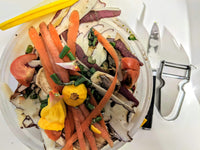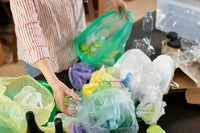Most household waste still ends up in landfills, not because people do not want to recycle, but because recycling systems are not designed for everything we throw away. Clear Drop enables a new way of managing soft plastic and organic waste right at home, making recycling easier, cleaner, and more efficient. Our goal is simple: remove the burden from households while ensuring that what leaves your home is actually processed, not discarded.
Why Clear Drop?
Clear Drop is a symbol of the neutral impact of humankind on nature. It is a metaphor for what remains after human consumption. Every day we as humans consume food and buy many products in packaging. It results in waste – plastic packaging, empty bottles, paper, glass, cans, organic waste etc. While only a marginal part of that is truly recycled, the footprint of human consumption is very high. The goal of Clear Drop is to reduce this footprint to a single clear drop.
A new concept of pre-recycling
Pre-recycling means optimizing waste at the source. Instead of hoping the recycling system will sort it out later, Clear Drop appliances prepare waste correctly right at home. It reduces volume, prevents contamination, and ensures soft plastics and food waste enter the proper recycling streams. The result: less landfill waste, fewer greenhouse gas emissions, and a straightforward approach households can stick to every day.
Pre-recycling is the approach that meets current challenges where the recycling system can’t deal with all types of waste we generate. Pre-recycling means preparing waste for its further efficient recycling before it is dropped into the recycling bin.
Currently, some materials tackled by Clear Drop’s home appliances are literally not recycled as soft plastic, not being collected conveniently enough. The regular recycling process is often ineffective: trucks “transporting air”, and labor-intensive separation – together they consume a lot of energy, resources and create pollution of their own.
With pre-recycling, discarded items are conveniently separated and prepared for recycling on the spot, facilitating waste reduction. Further on, the material is prepared for storing at home and further delivery to the recycling facilities of our partners. It is cleaner, denser, more convenient for transporting and all-around more manageable for further processing. Moreover, we guarantee recycling.
The actual problems we address
Challenging soft plastic waste
An estimated five trillion plastic bags are used annually worldwide, not including numbers of film packaging and other types of soft plastic. Only 1% of households can recycle film at home today. Less than 10% of soft plastic is recycled, and the data is still not always being calculated and reported. Unlike some traditionally recyclable commodities, such as PET bottles or HDPE bottles, there is not very much publicly available information on the generation and composition of film and flexible packaging.
Soft plastic is perceived as a barrier to the efficient process of recycling other types of plastic while being put together in a blue bin for recycling, as described in more detail in our overview of soft plastic recycling challenges.
Soft plastics are lightweight, flexible and inexpensive to produce. This has made them popular choices for packaging. But this ignores the problems of disposal, including harm to nature and people when it ends up in landfills.
Unless it’s compacted in a solid substance that changes the process of processing, soft plastics can get tangled or stuck in machinery at recycling or waste-processing facilities, causing inefficiencies and disruptions in the process.
Clear Drop solution: compacting soft plastic waste
Clear Drop offers the first step in solving this problem – business and home appliances that can prepare soft plastic waste for further transportation and actual recycling.
Soft Plastic Compactor (SPC) significantly simplifies the soft plastic collection and transforms fluffy packaging into a shape-preserving 12 × 8 × 4-inch block.

It happens with the help of a patented plastic surface-softening technology to keep soft plastic compacted for storage and transportation that is safe for users and the environment.
SPC accepts all major types of soft plastic packaging (excluding PVC and PS which are dangerous by nature) like food wrappers, soft plastic containers, shopping bags, cling film, and other types of packaging from your purchases.
The device stores around one month of soft plastic waste and provides low energy consumption. The soft plastic prepared by the SPC is easy to pick up and transport, making it more manageable than any other option. The soft plastic block can be mailed to Clear Drop. We offer end-2-end service in collaboration with our recycling partners which adds more possibilities to soft plastic waste reduction in landfills.
Make Soft Plastic Recycling Easier
Turn bulky packaging into compact, ready-to-recycle blocks using the Clear Drop Soft Plastic Compactor (SPC). It simplifies storage, improves recycling efficiency, and guarantees that soft plastics will not go to landfill.
Learn more about Clear Drop® Soft Plastic Compactor (SPC)
How to Manage Soft Plastics at Home
Soft plastics are everywhere in the home – from delivery mailers and snack packaging to produce bags and wrapping film. To make sure they are handled properly and stay out of landfills:
- Keep soft plastics separate from bottles and other recyclables.
- Ensure packaging is empty and reasonably clean.
- Compact them to reduce storage space and prevent tangling at facilities.
- Send compacted blocks via Clear Drop’s mail-in service for guaranteed recycling.
This empowers households to contribute to a cleaner plastic supply chain with minimal effort.
Dealing with the consequences of organic waste
Organic waste is just as harmful to the environment as plastic if it ends up in landfills instead of being composted. When compostable materials, like food scraps and yard waste, are thrown in with regular trash, they end up in landfills. These materials could have been repurposed into nutrient-rich compost to enrich the soil and contribute to waste reducion, but instead, they take up valuable landfill space and contribute to 11% of the world’s greenhouse gas emissions.
In landfills, organic waste decomposes anaerobically (without oxygen), producing methane, a potent greenhouse gas. Methane is approximately 25 times more effective than carbon dioxide at trapping heat in the atmosphere, contributing significantly to climate change.
Organic waste in landfills contributes to the production of leachate – a toxic liquid that can seep into the ground, potentially contaminating soil and water sources.
Composting not only recycles nutrients but also helps sequester carbon in the soil, reducing atmospheric carbon dioxide levels. Without composting, this potential benefit is lost.
Organics Collector: new technology to close the loop for organic waste
To not let organic waste end up in a landfill, people don’t need to do composting by themselves to support waste reduction.
Clear Drop makes collecting organic waste at home convenient, uninterrupted and without an unpleasant smell, leaks, dissolving organic bags, flies or the necessity to frequently empty the bin with one more home appliance – Organics Collector.
Organics Collector (OC) stores and gradually accumulates food waste for several days up to one week. At the same time, the device helps to avoid the appearance of unpleasant odors and insects. Featuring non-energy-intensive processes, the OC consumes very little energy.

The unique combination of the O3 generator and filtration system makes sure unpleasant smell is eliminated. Additionally, while stored, the organics in OC undergo a dehumidification process, reducing their moisture content by 30–40%. This makes all OC-collected material easier to transport and pick up and preserves composting features of the material.
Once the bin is full, the dried organics can be disposed of at a municipal waste collection point or go to your local or community compost pit. You can also learn more about why electric composters are not real composting and how solutions like OC keep organics suitable for professional composting.
Collect Food Waste Without the Mess
The Clear Drop Organics Collector helps you store organic waste for several days odor-free and leak-free, reducing landfill emissions and keeping nutrients available for composting.
Discover Clear Drop® Organics Collector (OC)
Clear Drop® Founder's Message

“These are just the first two systems we’re bringing to market. The problem is massive, and Pre-recycling is still in its infancy. But many more solutions are coming. Our promise to the world is that everything processed by our appliances will be recycled — if disposed of properly. We wouldn’t do this if we couldn’t make a difference. Let’s work together to make our future look like a hopeful science fiction story — not the bleak dystopias we risk if we don’t change our approach to waste management.” – Ivan Arbouzov, Founder & CEO of Clear Drop®
Frequently Asked Questions
What is pre-recycling?
Pre-recycling is the process of separating and preparing waste at home to ensure it can be recycled efficiently instead of ending up in a landfill. It’s a form of smarter home waste management that optimizes materials before they enter traditional recycling systems.
Which types of plastic can Clear Drop SPC compact?
Clear Drop SPC handles major types of soft plastic packaging such as food wrappers, shopping bags, produce bags, bubble wrap, and other flexible plastics, excluding PVC and PS. These are typically the soft plastics that are not recyclable curbside.
Does Organics Collector make compost?
No. The Organics Collector (OC) does not make finished compost. It preserves essential organic matter by partially drying food scraps and controlling odors, ensuring they remain suitable for industrial or community composting.
How does Clear Drop ensure recycling actually happens?
Through partnerships with specialized recycling facilities and a mail-in system, Clear Drop guarantees that soft plastics processed by SPC are recycled responsibly, rather than being sent to landfill. Together with OC, these pre-recycling solutions turn home waste management into a reliable path to real recycling.


